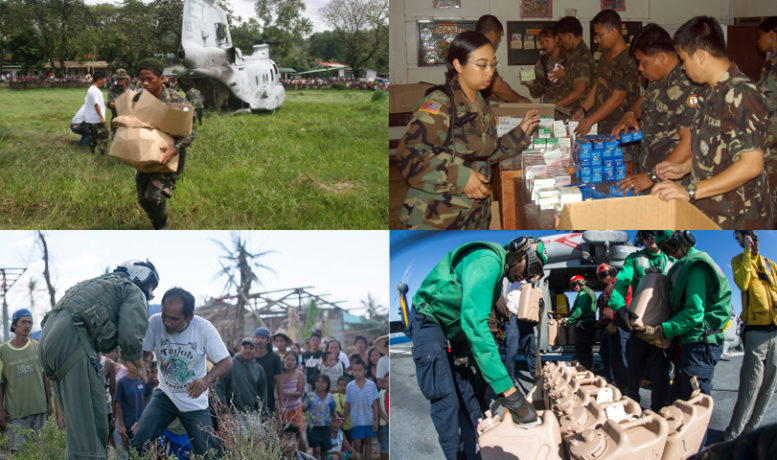Philippine President Duterte has recently forwarded notice to the United States (U.S.) his decision to terminate the current Visiting Forces Agreement (VFA) that has been in effect since 1999. This long-standing agreement is scheduled to renew or expire in August 2020. The concerns expressed by many -for or against this action- address many opinions of which I will try to explain in a simplified, orderly context of how I view the process.
When the U.S. ratified the 2020 government budget, contained within were line items addressing concern over the Philippine government’s war on drugs and alleged possible human rights violations. There was also concern expressed by the U.S. government over the detention of a Philippine Senator for violations of Philippine law. It should be noted the Philippine Supreme Court upheld the detention after two official appeals.
Two U.S. Senators were scheduled to travel to the Philippines for diplomatic discussions but were denied entry over the disagreement of what was published regarding the controversy. A Philippine Senator was later scheduled to travel to the U.S. but entry was denied by the U.S.
The saber rattling by the two sovereign nations continued until the Philippine President decided to terminate the Philippine-U.S. VFA. The effects of that action will certainly ripple across the entire Philippine Military complex, and the civilian enterprises that support and receive support from the programs, as well as funding and training received under the VFA agreement. In response, U.S. President Donald Trump made public his thanks on scrapping the PH-U.S. VFA, and said, “No Problem, it will save us a lot of money.”
Below is a partial list of the benefits received under the VFA that could be lost.
2019: Balikatan Exercises
As part of the 2019 Balikatan Exercises, U.S., Philippine, and Australian forces worked together to hold health engagements and community relations events, and renovate 3 elementary schools in Orani, Bataan; Pangil, Laguna; and San Juan, Batangas (Source: U.S. Embassy).
2019: Embassy response to Sec. Locsin on assisting in the search for the missing pilot
Foreign Affairs Secretary Teodoro Locsin Jr sought assistance from the U.S. via Twitter on August 11 on the search for a plane and student pilot who had gone missing for 2 weeks in Aurora (Source: Rappler).
2018: USS Mustin helps Filipino fishermen in distress
On June 26, USS Mustin (DDG 89) rendered assistance to 2 distressed mariners whose fishing boat had suffered an engine malfunction, rendering the vessel inoperable. Mustin was conducting a routine patrol in the vicinity of the Philippines when watch standers sighted a fishing vessel with 2 Filipino fishermen onboard frantically waving.
After pulling alongside and communicating with the fishermen in Tagalog, it was determined the fishing vessel had engine trouble and was unable to stay with their fellow fishermen or return to shore. The 2 fishermen had water onboard, but no food; and were unable to communicate with the local Coast Guard. The Mustin crew provided immediate assistance. They contacted a nearby fishing vessel to relay the situation, then deployed their Rigid Hull Inflatable Boat (RHIB), and towed the adrift fishing vessel to rejoin their fellow fishermen (Source: U.S. Embassy).
2018: Kamandag 2 humanitarian assistance activities
U.S., Japanese, and Philippine forces participated in humanitarian and civic assistance projects, which includes the renovation of a high school and 2 daycare centers in Cavite, as part of exercise Kamandag 2. They also taught hundreds of local residence about lifesaving skills, disease prevention, and dental hygiene (Source: U.S. Embassy).
2017: U.S. military assistance during the Marawi siege
The U.S. military provided technical assistance to Philippine forces during the Marawi siege (Source: Inquirer.net).
2017: Balikatan 33 humanitarian assistance activities
As part of the 33rd Balikatan Exercises, U.S. and Philippine service members practiced ship to shore movement of military personnel and equipment, air operations, and aid distribution to bolster disaster response capabilities. They also constructed new classrooms and community buildings and renovated existing structures in Capiz, Leyte, and Eastern Samar, and supplied communities in Luzon and Central Visayas with over $400,000 of aid and emergency readiness equipment (Source: U.S. Embassy).
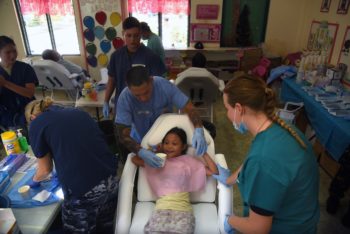
A girl from Bogo City finishes her dental treatment in Northern Cebu Province, Philippines. Photo credit: US Air Force.
2017: PACANGEL 17 humanitarian assistance activities
The U.S. and Philippine forces worked together to conduct humanitarian assistance engagements as part of Pacific Angel 2017 (PACANGEL 17). They partnered with local NGOs and other multilateral international participants to train together by providing medical, dental, optometrical, and engineering assistance, and conducting subject matter exchanges in Bogo City and San Remigio, Northern Cebu. They also partnered with local schools and health clinics to repair and update infrastructure (Source: U.S. Embassy).
2015: USNS Mercy humanitarian assistance activities
During the visit of the hospital ship USNS Mercy, engineers from the U.S. Navy, U.S. Air Force, the Armed Forces of the Philippines (AFP) and the Japan Self Defense Force built a school building from the ground up. In addition, they built a health center and refurbished 3 school buildings damaged during Typhoon Yolanda in 2013 (Source: U.S. Pacific Fleet).
2015: U.S. assistance during the Mamasapano Operations
At the request of the AFP, the U.S. service members serving in the JSOTF-P (Joint Special Operations Task Force-Philippines) responded to assist in evacuation of dead and wounded after a firefight between the Philippine military and high value targets in Mamasapano, Maguindanao (Source: MindaNews).
2013: Typhoon Haiyan (Yolanda)
U.S. military response efforts comprised more than 13,400 military personnel, 66 aircraft, and 12 naval vessels that delivered over 2,495 tons of relief supplies and evacuated more than 21,000 people. More than 1,300 flights were completed in support of the relief effort, delivering goods and services to approximately 450 sites (Source: NDU).
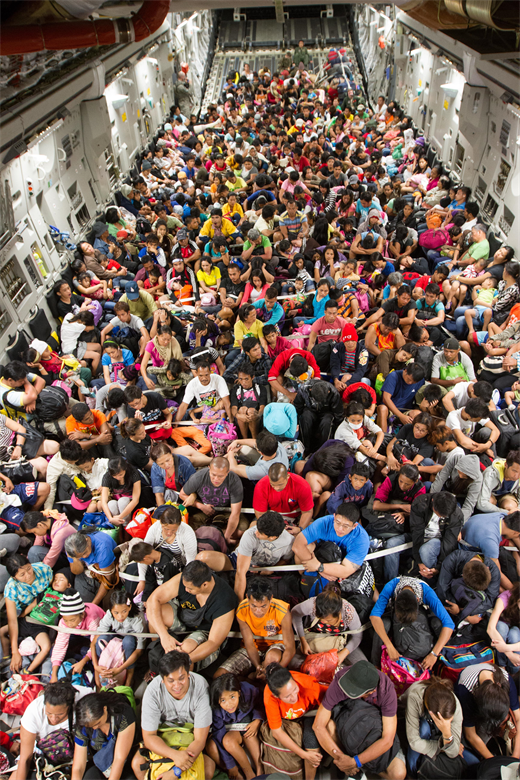
More than 670 Tacloban residents are evacuated on board a C-17 Globemaster III following Super Typhoon Haiyan. The C-17 was immediatly deployed to Clark Air Base from Hawaii in support of Operation Damayan humanitarian assistance and disaster relief effort. In addition to evactuation efforts, the C-17 also delivered more than 100,000 pounds of cargo. (Photo credit: US Air Force)
DOD funding: $34,500,000 (Source: USAID). The aircraft carrier USS George Washington and support vessels arrived in the Philippines on November 14 to give humanitarian assistance efforts in response to Typhoon Haiyan (Source: U.S. Navy).
When U.S. Sailors and Marines were dispatched to the central region of the Philippines in support of the Humanitarian Assistance-Disaster Relief mission “Operation Damayan,” Navy Recruiting District San Antonio recruiters answered the call from Nov. 20-27 with a donation drive to support those affected (Source: U.S. Navy).
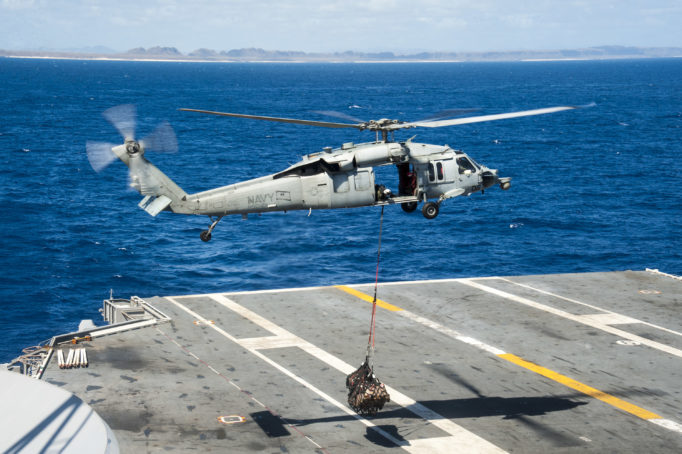
An MH-60S Sea Hawk helicopter from the Island Knights of Helicopter Sea Combat Squadron (HSC) 25 delivers supplies onto the flight deck of the aircraft carrier USS George Washington (CVN 73) during a replenishment-at-sea with the Military Sealift Command dry cargo and ammunition ship USNS Charles Drew (T-AKE 10) in support of Operation Damayan. The George Washington Carrier Strike Group supported the 3rd Marine Expeditionary Brigade to assist the Philippine government in response to the aftermath of the Super Typhoon Haiyan in the the Philippines. (Photo credit: US Navy)
2013: U.S. military assistance during the Bohol earthquake
A U.S. Marine Corps water purification unit, currently operated by the AFP engineers in Sagbayan, Bohol, produced 346,000 liters of free water for Filipinos affected by the earthquake. Another purification unit was being operated in Loon, a town only accessible via waterways (Source: U.S. Embassy Facebook page).
2012: U.S. military assistance during the 7.6 magnitude earthquake in Samar
Steaming toward its home port of San Diego after the 4-month Pacific Partnership 2012 mission, the crew aboard USNS Mercy watched the situation in the Philippines as a 7.6-magnitude earthquake struck, and made themselves ready to respond if called upon, the mission commander reported. Meanwhile, Navy Capt. James Morgan expressed confidence that disaster-relief training between the Pacific Partnership crew and the Philippine government and military during Mercy’s visit will pay off in improved response capabilities. (Seen in DoD)
2012: U.S. military assistance during Typhoon Bopha (Pablo)
On December 16, the U.S. Department of Defense (DoD) completed its final airlift of emergency relief commodities from Manila to Davao City. Between December 9-16, DoD in coordination with USAID/OFDA and the AFP, transported approximately 14,700 family food packs, 30 MT of rice, 94 MT of high-energy biscuits, 3,400 pieces of plastic sheeting, 80 collapsible water containers, and various relief commodities.
In total, DoD delivered 756,800 pounds of humanitarian items, which were primarily provided by the Philippine government. Some relief items reached typhoon-affected coastal areas within one day of being airlifted from Manila to Davao City. Additionally, DoD flew 131 flight hours in support of search-and-rescue operations (Source: USAID).
DOD funding: $570,803. 2 C-130 airplanes transported 14,700 family food packs, 500 hygiene kits, and 40 generators to Davao City; 3 water purification systems were also sent for access to safe drinking water, while personnel from the U.S. Joint Special Operations Task Force–Philippines assisted the AFP in relief efforts in Mindanao (Source: Marine Corps Installations Pacific).
The U.S. offered its air assets to the Philippine government to help fast track the transport of food and non-food items to help displaced residents in the typhoon-ravaged communities in Mindanao (Source: The Philippine Star).
2010: U.S. military assistance during Typhoon Megi (Juan)
DoD provided 4 aircrafts for aerial assessments and transport of personnel and supplies. Additional assets from the Amphibious Landing Exercise remained on stand-by for use following the damage assessments (Source: USAID).
2009: U.S. military assistance during Typhoons Ketsana (Ondoy), Parma (Pepeng), and Mirinae (Santi)
In the early stage of disaster response, DoD Pacific Command provided equipment, transport, and logistics support, 10 helicopters, and 6 Zodiac boats for search-and-rescue.
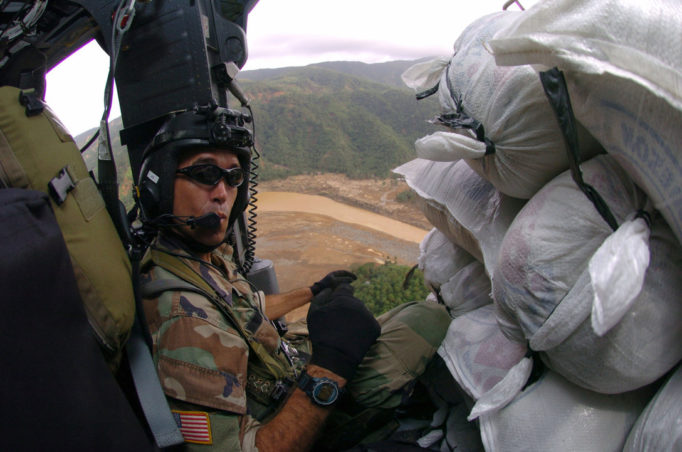
US Air Force and Marine helicopters deliver sacks of supplies to Real City, Philippines, during typhoon relief operations. About 600 US servicemembers provided humanitarian assistance and disaster relief to residents of Quezon Province where widespread flooding displaced about 168,000 people and left more than 1,400 dead or missing. (Photo Credit: US Air Force)
Between October 2-13, DoD assistance had a delivery flight of emergency relief supplies to Batanes, and transport of food and relief supplies to affected areas by road and helicopter. DoD medical teams screened 8,850 medical patients and 357 dental patients. DoD flights transported 262 passengers and moved 114,880 lbs of cargo. DoD engineers conducted 12 assessments, removed 1,385 cubic meters of debris, and cleared 2,650 meters of road (Source: USAID).
DOD funding: $827,581 (Emergency Relief Supplies, Logistics and Transportation). American troops helped the Philippine military’s clean-up efforts by sending heavy equipment, including bulldozers, scoop loaders, trucks, and hummer vehicles (Source: ABS-CBN News).
The U.S. military mobilized disaster relief operations across the Pacific in response to a series of tsunamis, earthquakes and severe storms that had devastated the region, the top U.S. commander in Asia said. U.S. Pacific Command Chief Admiral Timothy Keating told reporters, “some significant disaster relief operations are under way” in American Samoa, the Philippines and Indonesia. Two amphibious ships, USS Harpers Ferry and USS Tortuga, were off the coast of Manila with hundreds of U.S. marines onboard ready to provide medical aid and other help if needed (Source: Philippine Daily Inquirer).
2009: U.S. military assistance during Typhoon Pepeng/Parma
10 CH-46 helicopters, 18 combat raiding reconnaissance craft, 3 seven-ton trucks, and 2 dump trucks from the U.S. were used to transport rescue equipment from Metro Manila to Northern Luzon. The USS Harpers Ferry sailed to Lingayan Bay in Pangasinan for humanitarian work (Source: The Philippine Star).
U.S. troops holding military exercises nearby sent a C130 transport plane and 3 Chinook helicopters to help bring food and medicines to Baguio City in mountainous Benguet province, 250 kms (155 miles) north of the capital, and nearby areas cut-off by landslides (Source: ABS-CBN News).
The USS Denver Amphibious Ready Group (ARG) sent 2 ships to help the Philippine nation recover from Tropical Storm Ketsana and cope with the approaching Typhoon Parma. USS Tortuga (LSD 49), USS Harpers Ferry (LSD 46), and their embarked Marines conducted humanitarian assistance operations on Oct. 2 in Metro-Manila. The Marine air combat element on the 2 ships includes 10 CH-46E “Sea Knight” helicopters (Source: U.S. Navy).
2008: U.S. military assistance during Typhoon Frank/Fengshen
7 U.S. Navy Seahawk helicopters from USS Ronald Reagan, USS Howard and USS Thach have been working around the clock with the AFP, NDCC, and provincial government leaders to transport and deliver potable water and food supplies to the hardest hit areas in the Visayan region. U.S. military engineering teams had been working also with their Philippine counterparts to restore electrical power at major hospitals in the Iloilo region (Source: The Philippine Star).
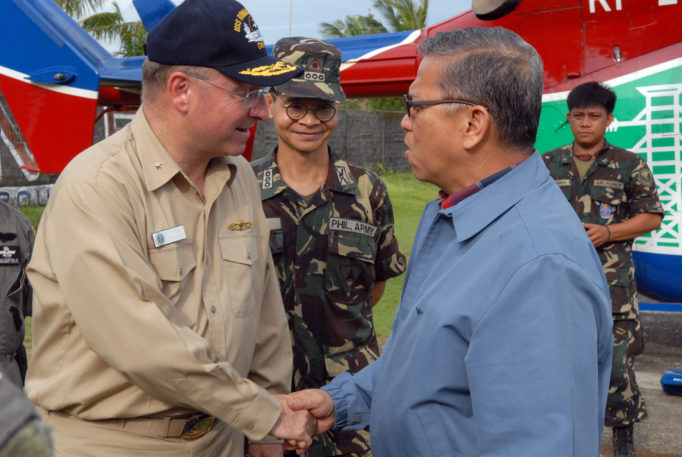
RAdm James P. Wisecup, shakes hands with DOE Secretary Angelo T. Reyes, upon arrival in Iloilo of The Ronald Reagan Carrier Strike Group (RRCSG) and the Military Sealift Command rescue and salvage ship USS Safeguard (T-ARS 50) after typoon Fengshen. The Military Sealift Command container & roll-on/roll-off ship USNS GYSGT Fred W. Stockham (T-AK 3017), a P-3C Orion aircraft and nine explosive ordnance disposal divers were already on station. The RRCSG provided humanitarian assistance and disaster relief to victims of the typhoon Fengshen. (Photo credit: US Navy)
USS Ronald Reagan and other U.S. Navy ships arrived on station near the Philippine island of Panay on June 25 to join the humanitarian assistance mission being led by AFP in the wake of damage caused by Typhoon Fengshen (Source: U.S. Navy).
The aircraft carrier USS Ronald Reagan (CVN 76) departed the Sulu Sea and the waters around Panay island on July 3, after assisting the Philippine government’s humanitarian relief operation (Source: U.S. Navy).
2006: U.S. military assistance during Typhoon Reming/Durian
Sailors from Naval Construction Battalion 7, Amphibious Construction Battalion 1, and Helicopter Mine Countermeasures Squadron 14, renovated a large bath and shower facility at a Typhoon Evacuation Center in Guinobatan on June 21 (Source: U.S. Navy).
1998: Typhoon Juan
U.S. Military humanitarian assistance included reconnaissance flight, distribution of relief goods and assessment of the area, plus air hub delivery (Source: U.S. Embassy Archives).
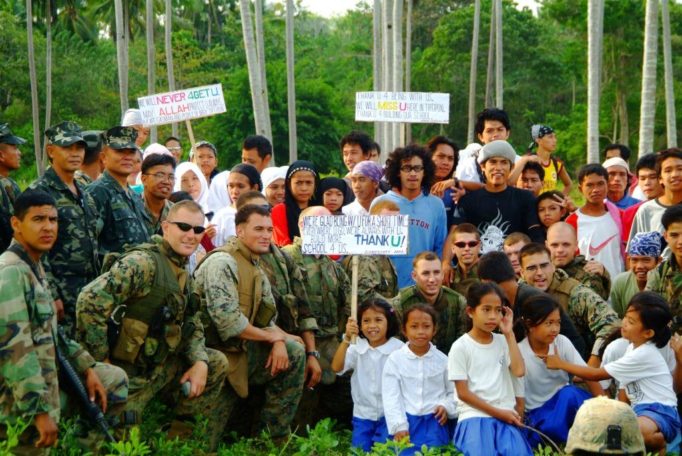
Philippine Marines and villagers from the nearby town of Tiptipon pose with U.S. Marines and Sailors assigned to the 31st Marine Service Support Group (MSSG) before they depart the island. (Photo credit: US Navy)
DFA Sec. Locsin expressed grave concern should this action move forward. His comments should be reviewed, and thought be given to the future. DFA Sec Locsin expressed the following concerns:
“The option for the Philippines to terminate the VFA is an exercise of sovereignty. The termination of the VFA may facilitate closer relations with non-traditional partners, such as, ideally, far-Russia – a power like the US, too far to meddle in our internal affairs without any acquisitive interest in our territory, yet strong and with a long enough reach to hit a common enemy in mutual defense.”
In the matter of national defense, closer relations cannot ever encompass a military alliance with a near power because that is illogical, impractical, self-defeating, and an invitation to foreign aggression.
However, the VFA termination must be weighed in terms of the country’s overall national interest. Here are 4 areas where the direct benefits derived from VFA are most manifest. Clearly, these are in respect of Philippine defense, military, and security arrangements.
The VFA ensures operability of other Philippines-US defense arrangements and modalities of cooperation.
Other PH-US agreements and modalities of defense and security operation may be rendered inoperative, despite remaining legally valid.
Some of these agreements and modalities of cooperation include the Mutual Defense Treaty (MDT), which the VFA serves. The Enhanced Cooperation Development Agreement, which gives substance to the commitments in the MDT. The Mutual Logistics Support Agreement and Mutual Defense Board-Security Engagement Board approved joint exercises on combatting traditional and non-traditional security threats, which is to say Islamic terrorists, with which we can never be at peace.
For the MDT, the VFA is the substance that makes it real and makes it work. EDCA, on the other hand, is hinged on VFA. There would essentially be no practical use for an EDCA in the absence of VFA, which is the legal framework for the presence of U.S. military personnel in military exercises and actual military responses under the MDT. Without them, the MDT is just a piece of paper. There are contrary views to this.
The VFA allows the U.S. to provide a total-package approach on defense articles that would be compatible with equipment, assets, and systems that are already in place.
There are again different views on this. But current military equipment, assets, and systems are largely patterned from and/or provided by the U.S. Through the years, the requirements for AFP modernization were addressed by the incremental procurement of defense articles that the Philippines has made after due diligence undertaken by relevant Philippine government agencies, specifically the Department of National Defense.
The dollar amount for security assistance security cooperation programs obtained from the U.S during 2016-2019 totals $554.55 million. This includes $267.75 million in foreign military financing for the procurement of defense articles for the same period. Under VFA, the Philippines is able to receive after-sales servicing maintenance packages that increase value and lifespan.
The U.S. plans to spend over $200 million in 2020-2021 providing aircraft, training, equipment, construction for the AFP, and more than $45 million in FMF (Foreign Military Financing).
Without the VFA, the U.S. Departments of State and Defense will be hard put to get funds, from the U.S. Congress for FMF and other defense assistance programs, to the Philippines.
The VFA promotes interoperability between the Philippine forces and law enforcement agencies and their US counterparts.
Again, we will listen to contrary views but for now, the Mutual Defense Board-Security Engagement Board have approved joint activities between the militaries and law enforcement agencies of both countries through the years.
The termination of the VFA may impact the upcoming fiscal year 2020 activities in which the Philippine military and law enforcement agencies need to enhance their capabilities in countering threats to national security. There are some 319 activities lined up for the year.
The absence of the VFA would result in a severe curtailment of defense engagements with the Philippines and the cancellation of cooperative defense activities in the Philippines as it provides the legal framework for the presence of U.S. forces in the Philippines. The U.S. will not operate without a VFA.
The VFA allows for the continued support for addressing non-traditional security threats.
Through VFA, U.S. forces have been instrumental in assisting the Philippines to combat non-traditional security threats such as human trafficking, cyberattack, terrorism, and illegal narcotics through training, joint exercises, and exchange visits. The U.S. has also provided support for humanitarian assistance and disaster response; and search and rescue operations.
Disaster response is more than humanitarian in purpose. The new military doctrine assumes that developments in warfare partake in destructiveness of natural calamities like typhoons and earthquakes. Thus, disaster response to natural or military inflicted calamities must be in the same scale.
No termination yet
DFA Sec. Locsin instead wants ‘vigorous review’ of VFA. Foreign Affairs Secretary Teodoro Locsin Jr admits he and Defense Chief Delfin Lorenzana were not consulted before President Duterte announced his order to terminate the PH-US VFA.
With threats to scrap VFA, Pres. Duterte gambles Philippines’ security. Duterte’s latest outburst against the U.S. isolates the country from its oldest ally, and sows uncertainty against the threat of any further Chinese aggression.
“U.S. assistance on counter-terrorism, especially on intelligence and capability-building, have proven to be vital. This support was crucial in enabling the Philippines security forces to prevail in the Battle of Marawi in 2017. Recently, the U.S. DoD support has enabled continued AFP operations to degrade ISIS-East Asia-aligned militants in Southern Philippines as well as several successful operations to rescue British and Indonesian citizens taken hostage by the Abu-Sayyaf Group. Curtailment of DoD support resulting from a terminated VFA would diminish the AFP‘s immediate capabilities to degrade and deter terrorism and respond to terrorist emergencies.”

Armed Forces of the Philippines Maj. Gen. Herminigildo Aquino, left, AFP Gen. Eduardo M. Año, the Honorable Ambassador Sung Y. Kim, Secretary Delfin N. Lorenzana, Under Secretary Ariel Y. Abadilla, AFP Lt. Gen. Oscar T. Lactao, and U.S. Marine Brig. Gen. Brian Cavanaugh stand “shoulder-to-shoulder” and shake hands during the Balikatan 2017 closing ceremony at Camp Aguinaldo, Quezon City, May 19, 2017. (Photo credit: US Air Force)
In addition to the potential loss of the benefits mentioned, there could be significant loss of support for U.S. Aid programs as well as other NGO programs currently operating in the Philippines. That would have a great negative impact for the disadvantaged victims who desperately need it.
In my opinion, the two world leaders should look past their differences for the benefit of those who could be most significantly impacted by such a drastic decision.
About the author:
- Timothy Muelder is a retired Facilities Manager of the U.S. Department of State.
